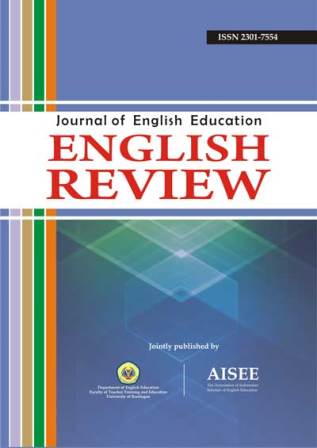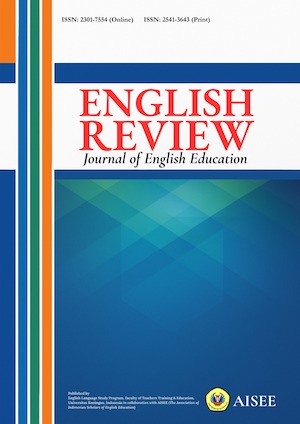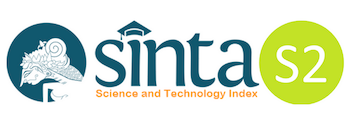Investigating Indonesian EFL Students’ Responses of the Implementation of Intercultural Language Learning
Abstract
This study aimed at discovering the students‟ responses to the implementation of intercultural language learning at the sixth semester students of the English Education Department, University of Singaperbangsa Karawang, Indonesia. The focus of the study was on 1) the students‟ general attitudes toward the course, 2) the students‟ attitudes toward the implementation of teaching and learning and 3) the students‟ responsibility as an intercultural person. This study was designed as a descriptive qualitative study that involved 31 participants. The data were collected through questionnaire and interviews. Based on the findings, the students gave positive responses to the implementation of intercultural language learning and they showed a greater interest in participating in the course. The intercultural language learning also proved that the students were given the opportunity to become intercultural speakers either during the teaching and learning process or in their daily life. Finally, it recommends that the intercultural approach should be implemented by other English teachers in any subject and at all levels of students.
Keywords: interculural language learning, intercultural competence, English as a foreign language.
References
Ary, D., Jacobs, L.C., Razavieh, A. (2002). Introduction to research in education. Michigan: Wadsworth, Thompson Learning.
Bredella, L. (2003). For a flexible model of intercultural understanding. In G. Alred., M. Byram., and M. Fleming. (Eds), Intercultural experience and education (p. 31-49). Clevedon: Multilingual Matters.
Brown, H. D. (1994). Principles of language learning and teaching. Englewood Cliffs, New Jersey: Prentice Hall Regents.
Byram, M., Gribkova, B., & Starkey, H. (2002). Developing the intercultural dimension in language teaching: A practical introduction for teachers. Strasbourg: Council of Europe
Champagne, C. & Bourdages, J.S. (2000). Didactiser la culture par la comparaison réflective. International Review of Applied Linguistics, 38, 279-287.
Corbett, J. (2003). An intercultural approach to English language teaching. Clevendon: Multilingual Matters.
Crozet, C., & Liddicoat, A.J. (2000). Teaching culture as an integrated part of language: Implications for the aims, approaches and pedagogies of language teaching. In A.J. Liddicoat & C. Crozet (eds), Teaching Languages, Teaching Cultures. Melbourne: Language Australia.
Damen, L. (1987). Culture learning: The fifth dimension in the language classroom. Massachusetts: Addison-Wesley Publishing Company, Inc.
Fraenkel, R. J. & Wallen, E. N. (1993). How to design and evaluate research in education. New York: Mcgraw-Hill
Gu, Q. (2005). Intercultural experience and teacher professional development. Regional Language Centre Journal, 36(1), 5-22.
Ho, S.T.K. (2009). Addressing culture in EFL classrooms: The challenge of shifting from a traditional to an intercultural stance. Electronic Journal of Foreign Language Teaching, 6(1), 63–76.
Kim, R. I. & Goldstein, S. B. (2005). Intercultural attitudes predict favorable study abroad expectations of U.S. college students. Journal of Studies in International Education, 9(3), 265-278.
Liddicoat, A. J. (2005b). Teaching languages for intercultural communication. In D. Cunningham and A. Hatoss (Eds), An international perspective on language policies, practices and proficiencies (p. 201–214). Belgrave: Editura Fundaţiei Academice Axis and Fédération Internationale des Professeurs de Langues Vivantes.
Liddicoat, A. J. (2005c). Teaching languages for intercultural communication, in An International Perspective on Language Policies, Practices and Proficiencies (eds D. Cunningham and A. Hatoss), Editura Fundaţiei Academice Axis and Fédération Internationale des Professeurs de Langues Vivantes, Belgrave, p. 201–214.
Liddicoat, A. J. & Kohler, M. (2012). Teaching Asian languages from an intercultural perspective: Building bridges for and with students of Indonesian. In X. Song & K. Cadman (Eds), Bridging transcultural divides: Asian language and culture in global higher education (p. 73-99). Adelaide: University of Adelaide Press.
Liddicoat, A.J., & Scarino, A. (2013). Intercultural language teaching and learning. West Sussex: Wiley-Blackwell
Liddicoat, A.J., Scarino, A., Papademetre, L., & Kohler, M. (2003). Report on intercultural language learning. Canberra: Commonwealth Department of Education, Science and Training.
Lucas, J. S. (2003). Intercultural communications for international programs: An experientially-based course design. Journal of Research in International Education, 2(3), 301-314.
Moloney, R. & Harbon, L. (2010). Making Intercultural Language Learning Visible and Assessable. Intercultural Competence Conference, 1, 281- 303.
Otten, M. (2003). Intercultural learning and diversity in higher education. Journal of Studies in International Education, 7(1), 12-26.
Rodliyah, R.T. & Muniroh, R. D. D. (2012). The importance of incorporating the target culture in English language teaching. [Online]. Available at: http://file.upi.edu/Direktori/FPBS/JUR._PEND._BAHASA_INGGRIS/197308062002122ROJAB_SITI_RODLIYAH/The_Importance_of_Incorporating_the_Target_Culture_in_Englis.pdf.
Sukarno. (2012). Integrating local cultures in teaching English as a foreign language for character building. [Online]. Available at: http://lppmp.uny.ac.id/sites/ lppmp.uny.ac.id/files/8Sukarno%20FBS_.pdf.
Tantri, N.R. (2013). English as a global language phenomenon and the need of cultural conceptualizations awareness in Indonesian ELT. International Refereed & Indexed Journal of English Language & Translation Studies, 1(1), 37-49.
All articles published in English Review: Journal of English Education (ERJEE) are licensed under the Creative Commons Attribution 4.0 International License (CC BY 4.0).
Copyright Ownership
Authors retain the copyright of their articles and grant ERJEE the right of first publication. The journal is granted a non-exclusive license to publish, reproduce, and distribute the article in any format, medium, or platform, provided that proper credit is given to the original authors.
License Terms – CC BY 4.0
Under the Creative Commons Attribution 4.0 International License, others are free to:
- Share — copy and redistribute the material in any medium or format
- Adapt — remix, transform, and build upon the material for any purpose, even commercially
As long as they:
- Provide appropriate credit to the original author(s) and source
- Provide a link to the license (https://creativecommons.org/licenses/by/4.0/)
- Indicate if any changes were made
There are no restrictions on the reuse, reproduction, or adaptation of published articles as long as attribution is properly given.
Author Warranties
By submitting a manuscript to ERJEE, authors confirm that:
- The work is original and does not infringe any existing copyright.
- The manuscript has not been previously published and is not under consideration elsewhere.
- All sources and references are appropriately acknowledged.
- Necessary permissions have been obtained for any copyrighted materials used.










